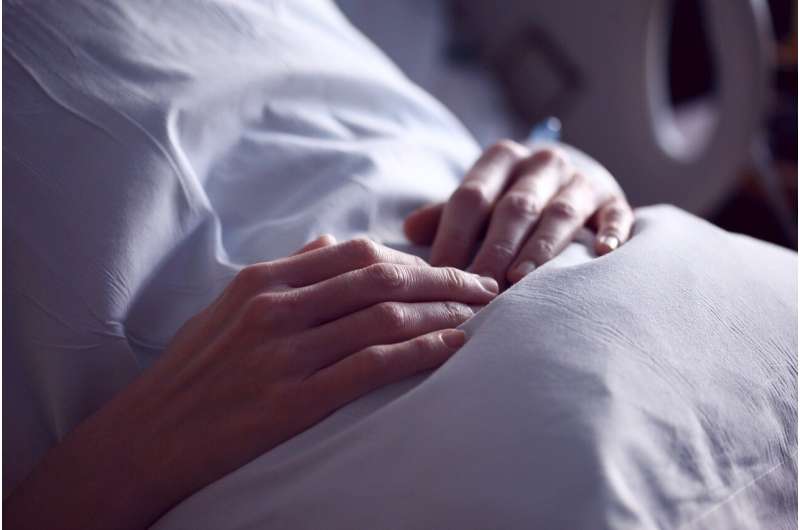This article has been reviewed according to Science X's editorial process and policies. Editors have highlighted the following attributes while ensuring the content's credibility:
fact-checked
proofread
Study shows sedative exams like endoscopy may require prolonged fasting for semaglutide users

A study published in the Journal of Clinical Anesthesia investigated the relationship between semaglutide use and residual gastric content in patients undergoing upper gastrointestinal endoscopy (EGD).
Conducted by researchers at the D'Or Institute for Research and Education (IDOR), the retrospective study analyzed medical records of 404 patients to assess the risks associated with semaglutide use, a glucagon-like peptide-1 (GLP-1) receptor agonist, in anesthetic procedures. The findings highlight the importance of revisiting preoperative fasting guidelines for patients on GLP-1 analogs to ensure the safety and efficacy of endoscopic procedures.
GLP-1 analogs in sedative exams
GLP-1 receptor agonists, also known as GLP-1 analogs, are medications that mimic the action of the GLP-1 hormone, whose primary role is blood sugar regulation by stimulating insulin secretion and inhibiting glucagon release, a substance that increases glucose levels in the body.
Among these agonists, semaglutide stands out for its convenient weekly dosing compared to other daily options, in addition to bringing positive weight loss effects to patients due to its appetite-reducing and gastric emptying-delaying effects.
While this latter effect is positive for increasing satiety, in anesthetic procedures it can present an increased risk for patients, such as those undergoing upper gastrointestinal endoscopy (EGD), as delayed digestion can result in residual gastric content during the exam.
Considering that there are few reports examining the correlation between GLP-1 analog use and residual gastric content in the anesthesiology literature, the researchers decided to investigate the relationship between semaglutide use in patients undergoing EGD, a procedure that needs to be performed under deep sedation or general anesthesia.
Analyzing medical records of patients undergoing EGD
During EGD, an endoscope is used to examine the upper gastrointestinal tract, including the esophagus, stomach, and duodenum. It is crucial to follow the necessary fasting hours so that the patient's stomach is empty during the procedure, ensuring a clear view of the internal structures and minimizing the risk of complications, such as the entry of foreign substances into the respiratory system (broncho-aspiration), which can occur if gastric content is present during the procedure.
The study was based on the retrospective analysis of over 800 electronic medical records from the Vila Nova Star Hospital in São Paulo. Patients who underwent EGD under deep sedation or general anesthesia between July 2021 and March 2022 were considered for the research.
Since the beginning of the research, the use of GLP-1 analogs was already mandatory during the institution's pre-anesthetic evaluations, which allowed for a more standardized analysis for the researchers.
After exclusion criteria, 404 EGD records were included in the final analysis. Patients were grouped according to those who received semaglutide once a week before EGD (SG group, with 33 individuals) and patients not exposed to semaglutide (NSG group, with 371 participants) in the 30 days prior to EGD.
The gender ratio was balanced in the research, and the patients were between 39 and 64 years old. In the SG group, the indication for semaglutide was mainly for weight loss (87.8%), while 12.2% had an indication for diabetes treatment.
Residual gastric content was observed in 24.2% of patients in the SG group, while in the NSG group, this metric was 5.1%. Of all the EGDs analyzed, only one case of bronchoaspiration was reported, in the semaglutide group.
The primary outcome was that there was an increase in residual gastric content in the semaglutide group, especially when patients reported gastric symptoms before EGD, such as nausea, vomiting, and abdominal distension.
Curiously, semaglutide showed the opposite effect when EGD was combined with colonoscopy, but the scientists believe that this relationship is due to the differentiated dietary recommendations for the latter exam.
Prolonged fasting may benefit semaglutide users in endoscopy
Preoperative fasting has long been adopted to reduce gastric residue and mitigate the risk of aspiration before anesthesia induction. Current guidelines recommend preoperative fasting of two hours for clear liquids and six to eight hours for solids and liquids with residue, and at the analyzed hospital these recommendations increased to four and 12 hours, respectively.
However, the findings of this study highlight that some patients may still have residue even after recommended preoperative fasting, which underscores the need for further research and guidelines for patients on GLP-1 analogs.
Scientists point out that, given the recent introduction of GLP-1 analogs into clinical practice, traditional fasting guidelines have largely ignored their delayed gastric emptying effect. This is a warning mainly for high-risk populations, such as complex oncology patients, who are the focus of care at Vila Nova Star Hospital.
The authors highlight that future studies should be tailored to different patient populations and argue that patients undergoing EGD who are on GLP-1 analogs should be instructed to follow significantly longer fasting intervals than those recommended by traditional guidelines, thus ensuring better technical conditions for this and other anesthetic procedures.
This study provides important evidence that semaglutide use can increase residual gastric content in patients undergoing EGD, especially in those with pre-existing gastric symptoms. These findings underscore the need for revised preoperative fasting guidelines for patients on GLP-1 analogs to ensure patient safety and optimal outcomes during endoscopic procedures.
Future research should focus on developing personalized fasting recommendations based on individual patient characteristics and medication regimens.
More information: Saullo Queiroz Silveira et al, Relationship between perioperative semaglutide use and residual gastric content: A retrospective analysis of patients undergoing elective upper endoscopy, Journal of Clinical Anesthesia (2023). DOI: 10.1016/j.jclinane.2023.111091




















